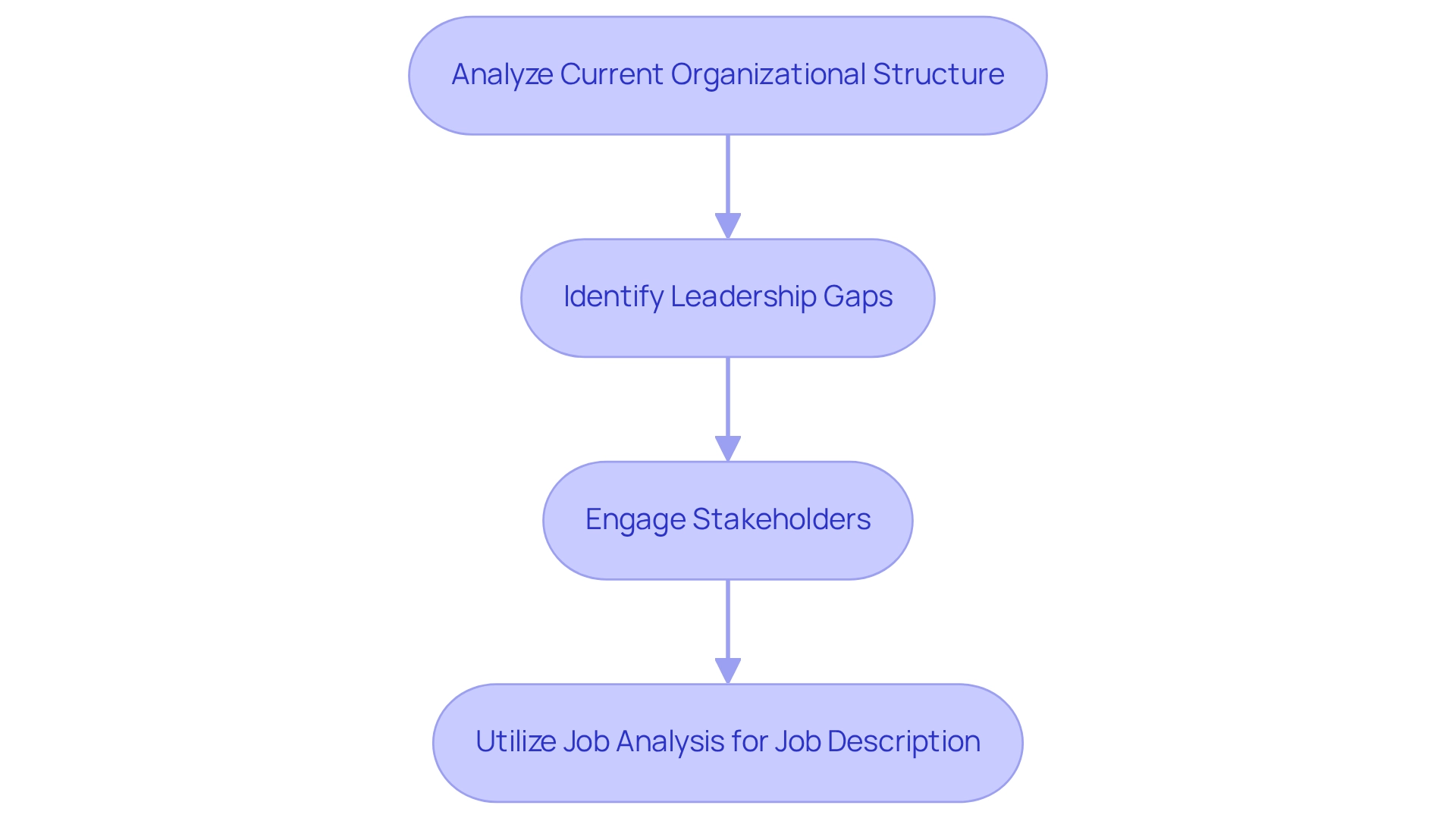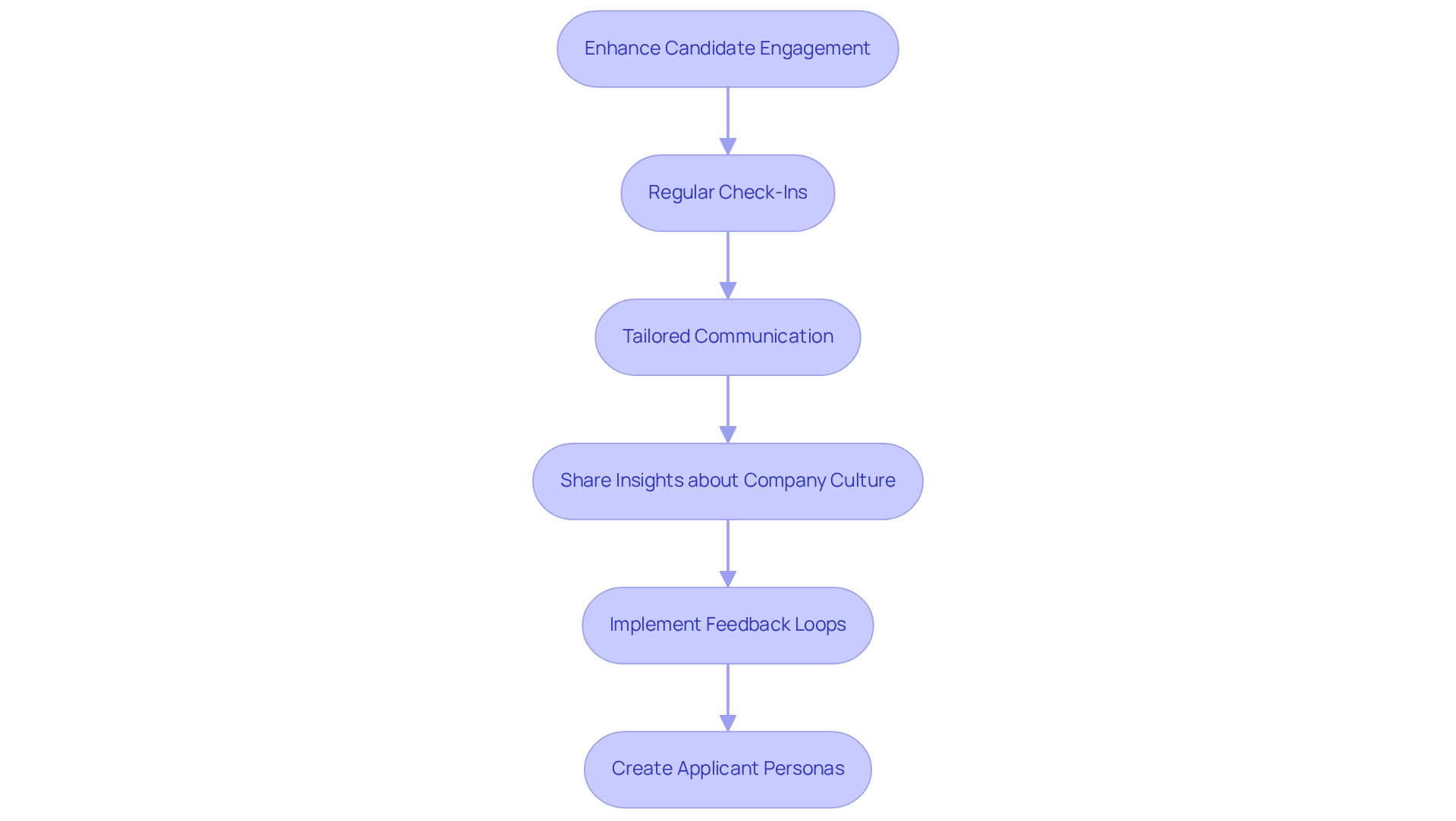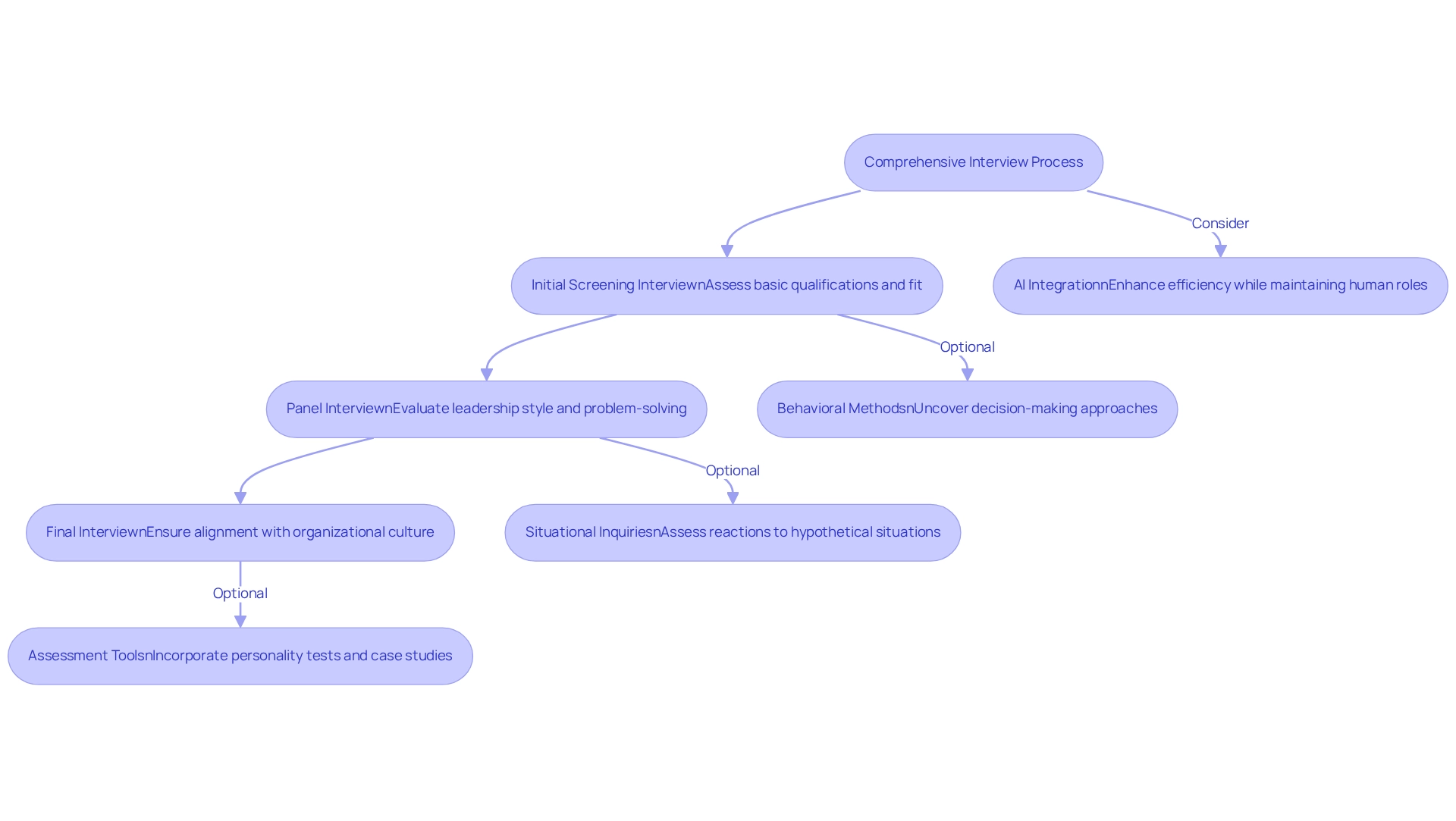Overview
Successful executive hires in 2025 will depend on four pivotal strategies:
- Evaluating organizational needs
- Employing personalized sourcing methods
- Fostering candidate engagement
- Implementing a comprehensive interview process
This article elucidates how these strategies—structured job analysis, data-driven candidate sourcing, transparent communication, and multi-stage interviews—are crucial for aligning candidates with organizational goals and enhancing the overall recruitment experience.
Key Highlights:
- Companies must evaluate their organizational structure to identify leadership gaps and required skills for executive roles.
- Engaging stakeholders is essential for understanding expectations and responsibilities tied to executive positions.
- Structured job analysis processes will be adopted by 60% of organizations to enhance recruitment strategies by 2025.
- Personalized sourcing strategies using data analytics and platforms like LinkedIn are crucial for identifying candidates who fit both qualifications and company culture.
- Clear communication regarding salary transparency is vital, as 50% of candidates find the lack of it frustrating.
- Building relationships through open communication and regular check-ins enhances candidate engagement and trust.
- Creating applicant personas helps tailor hiring processes to better meet the needs of target candidates.
- A comprehensive interview process should include multiple stages: initial screening, panel interviews, and final interviews with senior leadership.
- Incorporating behavioral and situational interview methods, along with assessment tools, improves candidate evaluation.
- 68% of employees favor a skills-based hiring approach, indicating a shift towards nuanced evaluation methods in recruitment.
Introduction
In the rapidly evolving landscape of executive recruitment, organizations must adapt their strategies to effectively attract and retain top talent. As they approach 2025, understanding specific organizational needs and role requirements has never been more critical. This article delves into the essential components of a successful hiring process.
- Defining leadership gaps
- Employing personalized sourcing strategies
- Fostering meaningful relationships with candidates
Each element plays a pivotal role. By embracing a comprehensive interview process and leveraging data-driven insights, companies can navigate the complexities of today’s talent market. Moreover, they can empower diverse leadership that aligns with their strategic objectives. As the competition for exceptional executives intensifies, the ability to engage and attract the right candidates will ultimately define organizational success.
Define Organizational Needs and Role Requirements
To effectively recruit executives in 2025, companies must commence with a meticulous evaluation of their specific needs. This procedure involves a thorough examination of the existing organizational structure, pinpointing leadership gaps, and identifying the essential skills and experiences required for the role. Engaging with key stakeholders is crucial to gather insights on the expectations and responsibilities tied to the position. By employing tools such as job analysis and competency frameworks, organizations can create a detailed job description that encompasses both technical and soft skills vital for success. This clarity not only attracts suitable candidates but also simplifies the selection process, ensuring alignment among all parties regarding expectations from the outset. Current trends indicate that organizations are increasingly recognizing the significance of outlining role requirements to effectively address leadership gaps. In 2025, it is anticipated that 60% of organizations will adopt structured job analysis processes to enhance their recruitment strategies. Furthermore, as the demand for innovative leadership rises, businesses must prioritize empowering women leaders to foster diverse and creative teams. By understanding and articulating their organizational requirements, businesses can navigate the complexities of executive hires, ultimately securing top talent that aligns with their strategic objectives.
- Conduct a thorough analysis of the current organizational structure.
- Identify leadership gaps and essential skills required for the role.
- Engage with stakeholders to gather insights on expectations.
- Utilize job analysis and competency frameworks to create a detailed job description.
Boutique Recruiting stands out as a partner in this endeavor, offering targeted recruitment services for accounting and marketing roles, including custom searches tailored to company needs. Additionally, in light of the economic instability related to COVID-19 and the projected increase in automation—which is expected to eliminate 85 million positions while generating 97 million new ones—companies must adjust their hiring strategies to remain competitive. Acknowledging common challenges faced by leaders, such as providing constructive feedback and adapting to new operating models, further underscores the necessity of a well-defined hiring process.

Utilize Personalized Sourcing Strategies
In 2025, organizations must embrace personalized sourcing strategies that transcend traditional recruitment methods. The necessity of utilizing data analytics is paramount for identifying individuals who possess not only the required technical qualifications but also align with the company culture. Platforms like LinkedIn can significantly enhance participant engagement, especially when reaching out to passive candidates who may not be actively seeking new opportunities. Networking events, industry conferences, and partnerships with executive search firms are invaluable avenues for sourcing high-caliber talent, especially for executive hires.
Furthermore, cultivating a compelling employer brand that effectively showcases the organization’s values and culture is vital. This approach not only attracts individuals who resonate with those characteristics but also increases their likelihood of engaging favorably with the recruitment process. As Amanda from Boutique Recruiting illustrates, establishing authentic connections with applicants can instill a sense of relaxation, understanding, and confidence prior to their interviews—a critical factor in today’s competitive landscape.
Moreover, as Morgane Lança notes, “50% of candidates find a lack of salary transparency frustrating,” underscoring the importance of clear communication in attracting top talent. With the demand for temporary staffing projected to rise by 25%, organizations that adeptly blend data-driven insights with personalized strategies will be better positioned to attract exceptional talent and achieve a lasting business impact.
While AI can enhance recruitment methods, it should not replace the human element, ensuring that the recruitment experience remains personal and engaging. The transition to hybrid work environments further highlights the necessity for a balanced approach; companies that successfully integrate technology with personalized strategies will not only draw top talent but also mitigate risks and enhance their overall hiring effectiveness.

Foster Relationships to Enhance Candidate Engagement
To cultivate relationships that significantly enhance applicant engagement, organizations must prioritize open communication and transparency throughout the recruitment process. Regular check-ins with applicants not only build rapport but also keep them informed about their application status, fostering a sense of connection. Personalizing communication—by addressing individuals by name and referencing specific interactions—can make them feel valued and respected. Furthermore, sharing insights into the company culture and the team they would potentially join can instill a sense of belonging even before formal employment begins. This level of transparency aids in establishing trust and allows hiring managers to evaluate applicants’ fit for positions efficiently.
Implementing feedback loops allows applicants to share their experiences during the recruitment process, enabling companies to refine their strategies and enhance overall applicant satisfaction. Significantly, companies that prioritize applicant experience observe a more engaged and productive workforce, with employees remaining 41% longer at organizations that encourage high internal mobility. This highlights the essential role of applicant engagement in recruitment success. As Niels Rozemeijer mentions, “If you are curious to see more NPS statistics, check out our latest Benchmark Reports here,” emphasizing the significance of measuring applicant satisfaction.
Furthermore, the case study titled “Defining Applicant Personas” emphasizes the creation of semi-fictional representations of ideal individuals based on data and research. By defining prospective personas, companies can customize their hiring processes to better meet the needs and motivations of their target audience, reinforcing the importance of personalization in communication.
Steps to Enhance Candidate Engagement:
- Conduct regular check-ins to keep candidates informed.
- Tailor communication by using individuals’ names and mentioning previous interactions.
- Share insights about company culture and team dynamics.
- Implement feedback loops to collect applicant experiences and enhance processes.
- Create applicant personas to customize hiring strategies effectively.
By implementing these strategies, companies can greatly boost applicant engagement and enhance their overall hiring success.

Implement a Comprehensive Interview Process
Implement a Comprehensive Interview Process
In 2025, organizations must adopt a comprehensive interview process that incorporates multiple stages to effectively evaluate executive candidates, including roles such as Chief of Staff, Executive Assistant, and Customer Service Representative. This approach typically begins with an initial screening interview, followed by a panel interview involving key stakeholders, and culminates in a final interview with senior leadership. Each phase should focus on particular elements of the applicant’s qualifications, such as leadership style, problem-solving abilities, and cultural compatibility within the company.
- Initial Screening Interview: Assess basic qualifications and fit.
- Panel Interview: Involve key stakeholders to evaluate leadership style and problem-solving capabilities.
- Final Interview: Conducted by senior leadership to ensure alignment with organizational culture.
Behavioral interview methods are especially beneficial, as they uncover how applicants have managed obstacles in their previous positions, offering insights into their decision-making approaches. Furthermore, situational inquiries can be utilized to assess how applicants might react to hypothetical situations pertinent to the context of the entity.
To further improve the evaluation system, entities should consider incorporating assessment tools such as personality tests or case studies. These tools not only assist in guaranteeing that applicants meet the technical requirements but also verify their alignment with the organization’s values and culture. Significantly, statistics show that 68% of employees now favor a skills-based hiring approach, reflecting a major shift towards more nuanced evaluation methods.
As the competition for talent grows stronger, it is essential for hiring managers to manage the interview experience smoothly, as leading applicants are not merely seeking any position but the ideal match with the suitable organization. Eric Eddy states, “Boutique Recruiting’s ability to deliver top-notch candidates quickly and efficiently” underscores the importance of effective hiring practices. Furthermore, with 45% of organizations identifying AI as a key factor in restructuring hiring practices, integrating technology into the recruitment process can enhance efficiency while maintaining the essential human element. By implementing these best practices, companies can improve their chances of securing top talent in a competitive landscape.

Conclusion
Navigating the complexities of executive recruitment in 2025 requires organizations to adopt a multi-faceted approach. First and foremost, defining organizational needs and role requirements is essential to identify leadership gaps and the specific skills necessary for success. By conducting thorough analyses and engaging key stakeholders, companies can create precise job descriptions that attract candidates who not only meet technical qualifications but also align with the organizational culture.
Moreover, the implementation of personalized sourcing strategies is vital. Embracing data analytics and leveraging platforms for targeted outreach can significantly enhance candidate engagement. Building a strong employer brand and maintaining open communication throughout the recruitment process fosters meaningful relationships with candidates, making them feel valued and respected. This commitment to transparency and connection ultimately enhances the overall candidate experience, leading to a more engaged workforce.
Finally, a comprehensive interview process that integrates behavioral and situational assessments is key to evaluating candidates effectively. By employing a structured approach that includes multiple stages and diverse evaluation methods, organizations can ensure they are selecting individuals who not only possess the required skills but are also a cultural fit.
As the competition for exceptional executives intensifies, organizations that prioritize these strategies will be better positioned to attract and retain top talent. The future of executive recruitment lies in understanding and articulating organizational needs, fostering genuine relationships, and implementing robust evaluation processes. By doing so, companies can secure the leadership that aligns with their strategic objectives and drives long-term success.
Frequently Asked Questions
What is the first step companies should take to recruit executives effectively in 2025?
Companies should begin with a meticulous evaluation of their specific needs, which includes a thorough examination of the existing organizational structure.
How can organizations identify leadership gaps during the recruitment process?
Organizations can identify leadership gaps by pinpointing the essential skills and experiences required for the role and analyzing the current organizational structure.
Why is engaging with stakeholders important in the recruitment process?
Engaging with stakeholders is crucial to gather insights on the expectations and responsibilities tied to the position, ensuring that all parties are aligned from the outset.
What tools can organizations use to create a detailed job description?
Organizations can utilize job analysis and competency frameworks to create a job description that encompasses both technical and soft skills vital for success.
What is the anticipated trend for organizations regarding job analysis processes in 2025?
It is anticipated that 60% of organizations will adopt structured job analysis processes to enhance their recruitment strategies.
How does the demand for innovative leadership affect recruitment strategies?
As the demand for innovative leadership rises, businesses must prioritize empowering women leaders to foster diverse and creative teams.
What challenges do leaders face that highlight the need for a well-defined hiring process?
Leaders commonly face challenges such as providing constructive feedback and adapting to new operating models, which underscores the necessity of a well-defined hiring process.
What role does Boutique Recruiting play in the executive recruitment process?
Boutique Recruiting offers targeted recruitment services for accounting and marketing roles, including custom searches tailored to company needs.
